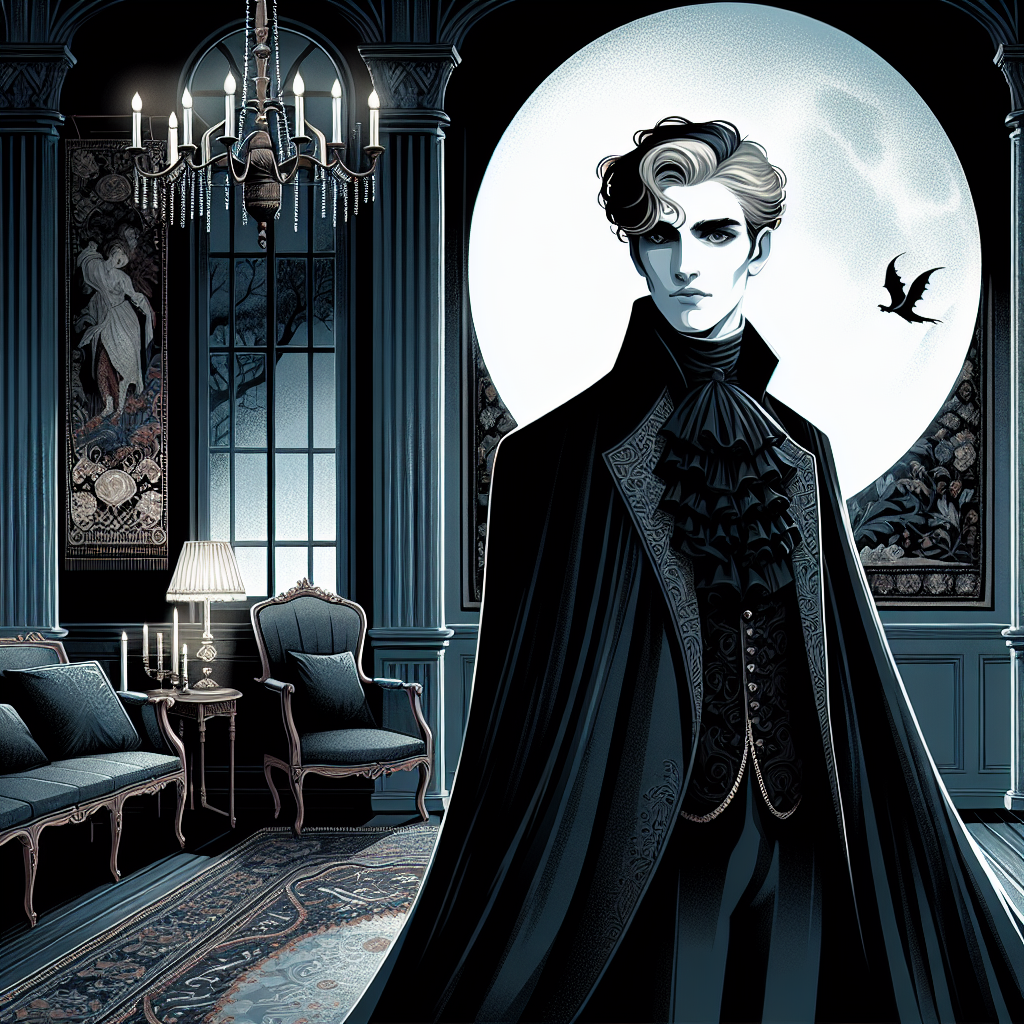The Ultimate Guide to Vampire Fashion: Decoding the Immortal Aesthetic
Vampires have captivated our imagination for centuries, weaving their way through folklore, literature, and modern media with an irresistible allure. What is it about these immortal beings that continues to fascinate us? Beyond their supernatural powers and eternal youth lies something equally compelling: their impeccable, darkly romantic sense of style.
The vampire aesthetic transcends mere fashion—it's a carefully crafted visual language that speaks to our deepest desires for mystery, power, and forbidden romance. From Bram Stoker's aristocratic Dracula to the brooding vampires of contemporary romance novels, these creatures of the night have maintained their status as style icons across generations.
What Defines the Vampire Aesthetic?
The vampire look is instantly recognizable, combining elements of danger and sophistication in a way that's both timeless and magnetic. This aesthetic draws from centuries of literary tradition, Gothic architecture, and our collective fascination with the supernatural.
At its core, vampire fashion represents the intersection of elegance and rebellion, refinement and raw power. It's a style that suggests someone who exists outside normal society's rules—someone who has had centuries to perfect their image and isn't concerned with fleeting trends.
The Nine Essential Elements of Vampire Style
1. Dark, Commanding Wardrobe
The foundation of any vampire's wardrobe is built on a palette of deep, rich colors. Black dominates, but deep burgundy, midnight blue, and charcoal gray also feature prominently. High-collared coats, flowing capes, and structured jackets create dramatic silhouettes that command attention while maintaining an air of mystery.
2. Ethereal Pale Complexion
That signature porcelain-pale skin isn't just about avoiding sunlight—it's a visual marker of otherworldliness. This ghostly pallor creates a striking contrast against dark clothing and suggests someone who exists between the world of the living and the dead.
3. Aristocratic Sharp Features
High cheekbones, defined jawlines, and angular features give vampires their predatory beauty. These sharp characteristics suggest both nobility and danger, creating faces that are simultaneously attractive and slightly unsettling.
4. The Predator's Mark: Fangs
Perhaps the most iconic vampire feature, fangs serve as both weapon and warning. Often concealed until the moment of truth, they remind us that beneath the sophisticated exterior lies a powerful predator.
5. Timeless Elegance
Centuries of existence have taught vampires to appreciate quality over trends. Their clothing choices reflect this wisdom—think perfectly tailored suits, luxurious fabrics, and classic cuts that never go out of style.
6. Meaningful Jewelry and Accessories
Vampire accessories tell stories. Family crests, ancient rings, ornate brooches, and mysterious amulets hint at long histories and supernatural powers. Each piece serves as both decoration and narrative device.
7. Mesmerizing Eyes
Often described in supernatural colors—deep crimson, icy silver, or molten gold—vampire eyes are windows to their otherworldly nature. These hypnotic gazes can entrance victims and reveal the predator lurking beneath the beautiful surface.
8. Supernatural Grace
The way vampires move sets them apart from mortals. They glide rather than walk, their movements fluid and silent, suggesting both their supernatural nature and predatory skills.
9. An Aura of Dangerous Magnetism
The most compelling aspect of vampire aesthetic isn't visual—it's the intangible sense of power and mystery they project. This magnetic presence draws people in despite the underlying danger.
Evolution of Vampire Fashion Through the Ages
Gothic Origins (18th-19th Century)
Vampire fashion traces its roots to European Gothic literature and the aristocratic styles of the 18th and 19th centuries. Early literary vampires like those in John Polidori's The Vampyre (1819) were depicted as sophisticated aristocrats, establishing the template for elegant, well-dressed bloodsuckers.
Bram Stoker's Dracula (1897) cemented many visual elements we still associate with vampires today: the dramatic cape, formal evening wear, and commanding presence that suggested both nobility and menace.
Victorian Opulence
Victorian-era vampire fashion embraced luxury and excess. Rich velvets, intricate lace, multiple layers, and ornate details reflected both the fashion of the time and the vampire's accumulated wealth and refined tastes. This style appears in works like Anne Rice's Interview with the Vampire, where characters like Lestat embody decadent historical luxury.
Modern Urban Evolution
Contemporary vampire fiction has updated the classic look for modern audiences. Today's literary vampires might sport leather jackets, fitted dark jeans, and sleek accessories while maintaining that essential air of mystery and danger. This evolution keeps vampires relevant while preserving their core aesthetic appeal.
Six Distinct Vampire Fashion Categories
1. Classic Gothic Elegance
The traditional Dracula look: flowing capes, high collars, formal suits, and vintage-inspired pieces that scream aristocratic refinement with a dark twist.
2. Victorian Romantic
Luxurious fabrics, intricate details, corsets, bustles, and elaborate accessories that transport viewers to a more opulent era of vampire mythology.
3. Modern Urban Sophisticate
Sleek leather jackets, perfectly tailored dark suits, designer accessories, and contemporary cuts that make vampires feel current and accessible.
4. Rebellious Punk Edge
Dark makeup, distressed leather, metal accessories, and an anti-establishment vibe that appeals to vampires who reject traditional society entirely.
5. Minimalist Mystery
Clean lines, simple but expensive pieces, and understated elegance that lets the vampire's natural magnetism take center stage.
6. Romantic Dark Academia
Vintage blazers, flowing fabrics, antique jewelry, and scholarly accessories that suggest centuries of accumulated knowledge and culture.
Vampire Style in Modern Romance Literature
Contemporary vampire romance has breathed new life into traditional vampire aesthetics, creating characters that balance classic supernatural elements with modern sensibilities. Here are some standout examples:
Raised by Vampires by Sarah Jamet
This novel showcases the contrast between ancient vampire nobility and innocent humanity through its characters. Rose Mcnoxnoctis embodies the traditional pureblood vampire aesthetic—elegant, powerful, and mysterious—while her adopted human daughter Eleanor represents the bridge between two worlds.
The Sapphire Queen by Silver Taurus
Amilia Vlad, the Princess of the Sapphire Eyes, exemplifies royal vampire fashion with her regal bearing and mysterious beauty. Her encounters with Vladimir Karatza, the King of All Vampires, showcase how vampire aesthetics can convey power dynamics and ancient hierarchies.
Sealed by Fate by Hayleigh White
This story demonstrates how modern vampire romance adapts classic elements for contemporary readers. Kierran McAllister represents the protective vampire archetype, his style balancing approachability with supernatural danger.
The Vampire's Call by M. Syrah
Grace and Haven's story illustrates how vampire aesthetics can shift between dream and reality, with Haven embodying the perfect vampire fantasy before revealing his true, more complex nature.
The Psychology Behind Vampire Fashion Appeal
Why do we find vampire style so compelling? The aesthetic taps into several psychological desires:
- Power Fantasy: Vampire fashion suggests unlimited resources, confidence, and authority
- Rebellion: The dark aesthetic appeals to our desire to break social conventions
- Mystery: The unknown elements create intrigue and fascination
- Timelessness: Classic styles suggest permanence in our rapidly changing world
- Sensuality: The combination of danger and beauty creates powerful romantic tension
Incorporating Vampire Aesthetic Into Modern Style
While full vampire cosplay might not be workplace appropriate, elements of vampire fashion can add sophistication and edge to contemporary wardrobes:
- Color Palette: Incorporate deep, rich colors and classic black pieces
- Silhouettes: Choose structured, well-tailored pieces that create dramatic lines
- Accessories: Add statement jewelry with vintage or gothic elements
- Fabrics: Invest in luxury materials like velvet, silk, and high-quality leather
- Attitude: Carry yourself with confidence and mysterious allure
The Future of Vampire Fashion
As vampire fiction continues to evolve, so too does vampire fashion. New interpretations blend traditional elements with contemporary trends, ensuring these immortal style icons remain relevant for new generations of readers and viewers.
Whether you're drawn to the classic Gothic elegance of traditional vampires or prefer the sleek sophistication of modern interpretations, the vampire aesthetic offers a rich tapestry of style inspiration that transcends time and trends.
The enduring appeal of vampire fashion lies in its ability to make us feel powerful, mysterious, and eternally stylish—even if we can't actually live forever. In a world of fast fashion and fleeting trends, perhaps there's something to be said for the vampire approach: invest in timeless pieces, cultivate an air of mystery, and never underestimate the power of a perfectly dramatic entrance.
💝 Ready to Explore More Romance?
If you enjoyed this article about Vampire writing, discover thousands of captivating love stories on our platform.
Download App







